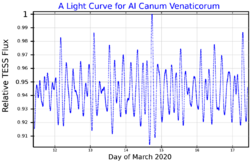Astronomy:4 Canum Venaticorum
| Observation data Equinox J2000.0]] (ICRS) | |
|---|---|
| Constellation | Canes Venatici |
| Right ascension | 12h 23m 47.01149s[2] |
| Declination | +42° 32′ 33.8670″[2] |
| Apparent magnitude (V) | +6.04[3] 5.89 to 6.15[4] |
| Characteristics | |
| Spectral type | F3 IV[5] or F0 III[6] |
| B−V color index | 0.366±0.005[7] |
| Variable type | δ Sct[8] |
| Astrometry | |
| Radial velocity (Rv) | −0.3±2.9[3] km/s |
| Proper motion (μ) | RA: −79.651[2] mas/yr Dec.: +13.203[2] mas/yr |
| Parallax (π) | 7.6829 ± 0.0960[2] mas |
| Distance | 425 ± 5 ly (130 ± 2 pc) |
| Absolute magnitude (MV) | +0.75[9] |
| Orbit[3] | |
| Period (P) | 124.44±0.03 d |
| Eccentricity (e) | 0.311±0.003 |
| Periastron epoch (T) | 2454605±10.3 JD |
| Argument of periastron (ω) (secondary) | 70.2±0.7° |
| Semi-amplitude (K1) (primary) | 13.24±0.05 km/s |
| Details[3] | |
| 4 CVn A | |
| Mass | 1.0–2.0 M☉ |
| Radius | 3.7–4.1 R☉ |
| Luminosity | 295+3.6 −3.2 L☉ |
| Surface gravity (log g) | 3.30±0.35 cgs |
| Temperature | 6,875±120 K |
| Metallicity [Fe/H] | −0.05±0.15 dex |
| Rotational velocity (v sin i) | 109±3 km/s |
| Other designations | |
| Database references | |
| SIMBAD | data |
4 Canum Venaticorum is a binary star system in the northern constellation of Canes Venatici, located around 425 light years away.[2] It has the variable star designation AI Canum Venaticorum; 4 Canum Venaticorum is its Flamsteed designation. Its brightness varies from magnitude +5.89 to +6.15 with a period of 2.8 hours,[4] which places it around the lower limit of visibility to the naked eye. This was found to be a binary by Schmid et al. in 2014, based on periodic, non-sinusoidal changes in its radial velocity. It is a single-lined spectroscopic binary with an orbital period of 124.4 days and an eccentricity of 0.31.[3]
The primary component is an evolved F-type star with a stellar classification of F3 IV[5] or F0 III,[6] matching a subgiant or giant star, respectively. It is a variable of the Delta Scuti class, displaying both radial and non-radial pulsations.[8] The variable nature of this star was discovered by D. H. P. Jones and C. Margaret Haslam in 1966 at the suggestion of Olin J. Eggen,[11] and it has become one of the best studied stars in its class. The radial pulsations have shown little if any variations between 1974 and 2012. However, the non-radial pulsations vary continuously in frequency over periods spanning decades.[8] It is spinning rapidly with a rotation of at least one third of its critical velocity.[3]
References
- ↑ "MAST: Barbara A. Mikulski Archive for Space Telescopes". Space Telescope Science Institute. https://mast.stsci.edu/portal/Mashup/Clients/Mast/Portal.html.
- ↑ 2.0 2.1 2.2 2.3 2.4 2.5 Brown, A. G. A. (August 2018). "Gaia Data Release 2: Summary of the contents and survey properties". Astronomy & Astrophysics 616: A1. doi:10.1051/0004-6361/201833051. Bibcode: 2018A&A...616A...1G. Gaia DR2 record for this source at VizieR.
- ↑ 3.0 3.1 3.2 3.3 3.4 3.5 Schmid, V. S. et al. (October 2014), "Discovery of binarity, spectroscopic frequency analysis, and mode identification of the δ Scuti star 4 CVn", Astronomy & Astrophysics 570: 17, doi:10.1051/0004-6361/201423669, A33, Bibcode: 2014A&A...570A..33S.
- ↑ 4.0 4.1 Samus, N. N. et al. (2017), "General Catalogue of Variable Stars", Astronomy Reports, 5.1 61 (1): 80–88, doi:10.1134/S1063772917010085, Bibcode: 2017ARep...61...80S.
- ↑ 5.0 5.1 Morgan, W. W.; Abt, H. A. (February 1972), "The spectral classification of the F stars of intermediate luminosity", Astronomical Journal 77: 35–37, doi:10.1086/111242, Bibcode: 1972AJ.....77...35M
- ↑ 6.0 6.1 Appenzeller, Immo (April 1967), "MK Spectral Types for 185 Bright Stars", Publications of the Astronomical Society of the Pacific 79 (467): 102, doi:10.1086/128449, Bibcode: 1967PASP...79..102A.
- ↑ Anderson, E.; Francis, Ch. (2012), "XHIP: An extended hipparcos compilation", Astronomy Letters 38 (5): 331, doi:10.1134/S1063773712050015, Bibcode: 2012AstL...38..331A.
- ↑ 8.0 8.1 8.2 Breger, M. et al. (March 2017), "Nonradial and radial period changes of the δ Scuti star 4 CVn. II. Systematic behavior over 40 years", Astronomy & Astrophysics 599: 8, doi:10.1051/0004-6361/201629797, A116, Bibcode: 2017A&A...599A.116B.
- ↑ Eggen, Olin J. (July 1998), "The Age Range of Hyades Stars", The Astronomical Journal 116 (1): 284–292, doi:10.1086/300413, Bibcode: 1998AJ....116..284E.
- ↑ "4 CVn". SIMBAD. Centre de données astronomiques de Strasbourg. http://simbad.u-strasbg.fr/simbad/sim-basic?Ident=4+CVn.
- ↑ Jones, D. H. P.; Haslam, C. M. (February 1966), "A new delta Scuti variable", The Observatory 86: 34, Bibcode: 1966Obs....86...34J.
 |


